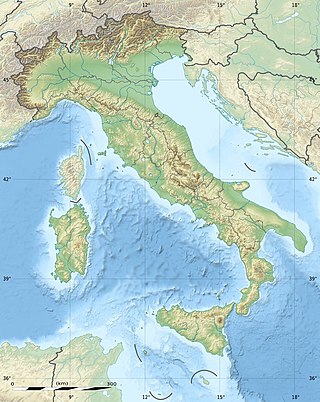 | |
| Continent | Europe and Africa (Lampedusa and Lampione islands) |
|---|---|
| Region | South Europe |
| Coordinates | 42°00′N 12°05′E / 42.000°N 12.083°E |
| Area | |
| • Total | 301,230 km2 (116,310 sq mi) |
| • Land | 97.61% |
| • Water | 2.39% |
| Coastline | 7,900 km (4,900 mi) |
| Borders | Total land borders 1,836.4 km (1,141.1 mi) |
| Highest point | Mont Blanc 4,810 m (15,780 ft) |
| Lowest point | Jolanda di Savoia −3.44 m (−11.3 ft) |
| Longest river | Po 652 km (405 mi) |
| Largest lake | Garda 370 km2 (140 sq mi) |
| Exclusive economic zone | 541,915 km2 (209,235 sq mi) |
The geography of Italy includes the description of all the physical geographical elements of Italy. Italy, whose territory largely coincides with the homonymous geographical region,[1] is located in southern Europe and comprises the long, boot-shaped Italian Peninsula crossed by the Apennines, the southern side of Alps, the large plain of the Po Valley and some islands including Sicily and Sardinia. Italy is part of the Northern Hemisphere. Two of the Pelagie Islands (Lampedusa and Lampione) are located on the African continent.
The total area of Italy is 301,230 km2 (116,310 sq mi), of which 294,020 km2 (113,520 sq mi) is land and 7,210 km2 (2,784 sq mi) is water. It lies between latitudes 35° and 47° N, and longitudes 6° and 19° E. Italy borders Switzerland (698 km or 434 mi), France (476 km or 296 mi), Austria (404 km or 251 mi) and Slovenia (218 km or 135 mi). San Marino (37 km or 23 mi) and Vatican City (3.4 km or 2.1 mi) are enclaves. The total border length is 1,836.4 km (1,141.1 mi). Including islands, Italy has a coastline of 7,900 km (4,900 mi) on the Adriatic Sea, Ionian Sea, Tyrrhenian Sea, Ligurian Sea, Sea of Sardinia and Strait of Sicily.
The Italian geographical region,[2][3] in its traditional and most widely accepted extent, has an area of approximately 324,000 square kilometres (125,000 sq mi),[2] which is greater than the area of the entire Italian Republic (301,230 square kilometres or 116,310 square miles). The Italian geographical region also includes territories that are sovereign parts of Croatia, France, Slovenia and Switzerland, as well as the four small independent states of the Principality of Monaco, the Republic of Malta, the Republic of San Marino and the Vatican City State (the Holy See).[4]
- ^ "Italia", Dizionario enciclopedico italiano (in Italian), vol. VI, Treccani, 1970, p. 413
- ^ a b "Italia". L'Enciclopedia Geografica (in Italian). Vol. I. De Agostini Ed. 2004. p. 78.
- ^ "La presentazione di una storia delle frontiere orientali italiane: una occasione per riflettere sulle determinanti storiche, economiche e geopolitiche dei confini" (in Italian). Working Paper n. 2007-41, Università degli Studi di Milano. 2007. doi:10.2139/ssrn.1023852. S2CID 127530700. Retrieved 29 January 2022.
{{cite journal}}: Cite journal requires|journal=(help) - ^ "Archives historiques de la Suisse italienne - Volumes 9-11". Université de Californie. 1934. Retrieved 29 January 2022.